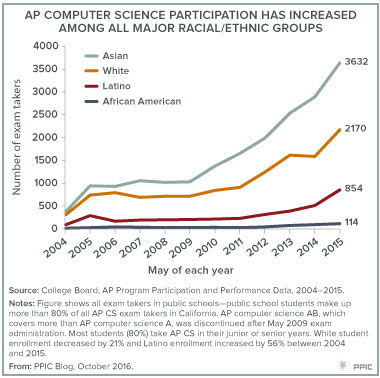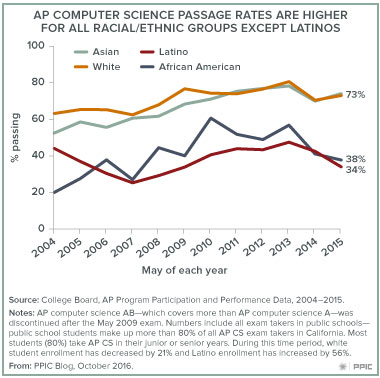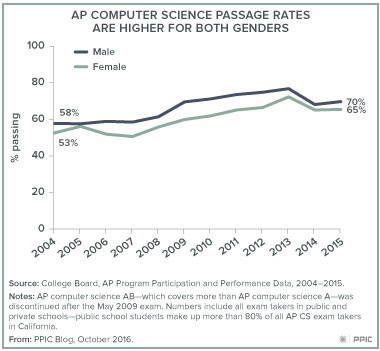 Assembly Bill 2329—just signed by the governor—requires the state superintendent of public instruction to convene an advisory panel to develop computer science standards for California’s public schools. A look at the current state of computer science education reveals that this effort will entail a number of challenges and opportunities.
Assembly Bill 2329—just signed by the governor—requires the state superintendent of public instruction to convene an advisory panel to develop computer science standards for California’s public schools. A look at the current state of computer science education reveals that this effort will entail a number of challenges and opportunities.
More Students Than Ever Are Taking AP Computer Science Exams
In 2015, a record-high 7,254 students from California’s public schools took the AP computer science exam, an eightfold increase from 2004. Test participation has grown across major demographic groups. After adjusting for fluctuations in student enrollment, particularly in grades 11 and 12 when students typically take the exam, white and Asian students made the most progress, with participation rate up by 800% or more. Growth has been slower among African American (690%) and Latino students (550%).
Test Performance Has Improved for Most Racial/Ethnic Groups
 Although increasing numbers of Latino students are taking the exam, passage rates for this group have declined. In May 2004, 44% of Latino exam takers passed, compared to 34% percent in 2015. Performance has improved modestly among Asian and white students. The trend for African American students is less meaningful, because very few of them took the exam (fewer than 50 African Americans took the test before 2013).
Although increasing numbers of Latino students are taking the exam, passage rates for this group have declined. In May 2004, 44% of Latino exam takers passed, compared to 34% percent in 2015. Performance has improved modestly among Asian and white students. The trend for African American students is less meaningful, because very few of them took the exam (fewer than 50 African Americans took the test before 2013).
More Girls Are Taking Computer Science Exams
In 2015, 26% of AP Computer Science exam takers were female, up from 19% in 2004. Over time both girls and boys have seen an improvement in performance. The gender gap, after some fluctuations, has largely remained unchanged.
 Few Schools Offer Computer Science Courses, and Quality Varies
Few Schools Offer Computer Science Courses, and Quality Varies
Few schools statewide are offering computer science courses and many of the courses that are offered—popular classes such as computer literacy and computer lab—are not rigorous enough to prepare students for college and beyond. In addition, finding teachers, especially for rigorous computer science courses, remains a challenge. For instance, out of 1,601 high and K–12 schools in California, only 142 offered computer programming courses, half of which are not meeting UC/CSU entrance requirements (author calculation using 2014–15 data from the California Department of Education).
California’s new law is an important first step to expand computer science education across the state. A recently introduced K–12 computer science framework developed by a national coalition of states, districts, and computer science organizations may be helpful as California develops its own standards. At the same time, continuing gaps in performance and variation in course access and quality represent an ongoing challenge.
Read the report Upgrading Technology Infrastructure in California’s Schools and the fact sheet “Digital Learning in California’s K–12 Schools”


